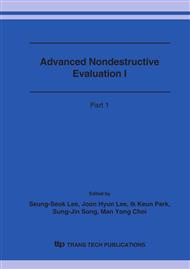p.400
p.404
p.410
p.414
p.420
p.426
p.430
p.434
p.441
Prediction and Analysis of ECT Signals due to Tube Defects near Support Plate in Steam Generator
Abstract:
In this paper, absolute and differential eddy current signals from various shapes and sizes of defects in the steam generator tube are numerically predicted and their slope characteristics are investigated. The signal variations due to frequency increase are also observed. Then, the analysis of mixed defect signals affected by a ferromagnetic support plate is attempted. Axisymmetric finite element modeling is used for signal prediction and the slope angle of signal is used importantly in analyzing the signal. Results show that differential signals are useful for locating the position of a defect inside the support plate hole, while absolute signals are easy to presume and interpret even though the effect of support plate is mixed in the signal. Understanding of respective signal characteristics and relationship between them will be helpful for more reliable defect characterization.
Info:
Periodical:
Pages:
420-425
Citation:
Online since:
October 2006
Authors:
Keywords:
Price:
Сopyright:
© 2006 Trans Tech Publications Ltd. All Rights Reserved
Share:
Citation:


